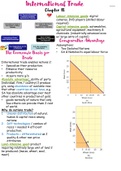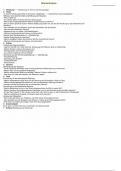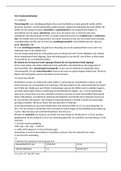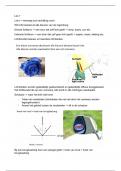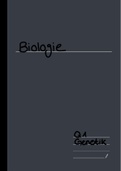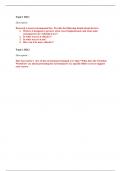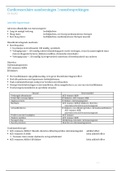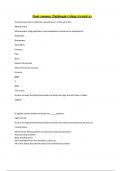International Trade
Chapter 18
Labour-intensive goods: digital
cameras, DVD players (skilled labour
required)
Capital-intensive goods: automobiles,
agricultural equipment, machinery &
chemicals. (industrially advanced ecos
w/ large amts of capital)
Comparative Advantage
Assumptions:
• Two Isolated Nations
The Economic Basis for • SA & Namibia hv equal labour force
Trade
International trade enables nations 2:
• Specialize their production;
• Enhance their resource
productivity;
• Acquire more g/s.
Absolute advantage: ability of party
(individual, firm / country) 2 produce
g/s, using abundance of available resc
that other countries do not have, e.g.
SA has absolute advantage over most
other countries in production of gold.
• goods normally of nature that only
few others can provide them 2 rest
of world.
Why do nations trade?
1. Uneven distribution of natural,
human & capital rescs among
nations;
2. Diff technologies / combos of
rescs = needed 4 efficient
production;
3. Products = differentiated as 2
quality & other non-price
attributes.
Land-intensive good: product
requiring relatively large amt of land 2
be produced. (maize, wheat, wool,
meat)
, Comparative advantage: lower
relative opportunity cost than that of
another producer / country.
Gains from Trade
3 realities relating 2 PPC: Trading possibilities line: line that
1. Constant cost: curves drawn as shows diff combinations of two
straight lines (contrast 2 bowed products that an eco = 2 to obtain
outward PPC) – replaces law of (consume) when it specializes in
increasing opportunity cost w/ production of 1 product & trades
assumption of constant cost. (exports) it 2 obtain other product.
2. Different cost: PPC of SA &
Namibia reflect diff resc mixes &
differing lvls of technological
progress. Differing slopes of 2
curves tell tht opp cost of
producing wheat & meat differ
btw 2 nations.
3. SA absolute advantage in both: if
use entire equal size labour force
2 produce meat/wheat, SA can
produce more of both (output per
worker – labour productivity- in
SA higher).
Opportunity–cost ratio: equivalency
showing # of units of 2 products that
can be produced w/ same rescs; opp
cost of 1 corn & 3 olives using same
resources shows that same rescs
required 2 produce 3 units of olives
must be shifted 2 corn production 2
produce 1 unit of corn.
Terms of Trade
• 1M ≡ 1W in SA (sign means
‘equivalent 2”)
• 1W ≡ 2C in Namibia
Rate @ which units of 1 product can be
exchanged 4 units of another product;
price of g/s; amount of 1 g/s that must
be given up 2 obtain 1 unit of another
g/s.
Self-Sufficiency Output Mix
Chapter 18
Labour-intensive goods: digital
cameras, DVD players (skilled labour
required)
Capital-intensive goods: automobiles,
agricultural equipment, machinery &
chemicals. (industrially advanced ecos
w/ large amts of capital)
Comparative Advantage
Assumptions:
• Two Isolated Nations
The Economic Basis for • SA & Namibia hv equal labour force
Trade
International trade enables nations 2:
• Specialize their production;
• Enhance their resource
productivity;
• Acquire more g/s.
Absolute advantage: ability of party
(individual, firm / country) 2 produce
g/s, using abundance of available resc
that other countries do not have, e.g.
SA has absolute advantage over most
other countries in production of gold.
• goods normally of nature that only
few others can provide them 2 rest
of world.
Why do nations trade?
1. Uneven distribution of natural,
human & capital rescs among
nations;
2. Diff technologies / combos of
rescs = needed 4 efficient
production;
3. Products = differentiated as 2
quality & other non-price
attributes.
Land-intensive good: product
requiring relatively large amt of land 2
be produced. (maize, wheat, wool,
meat)
, Comparative advantage: lower
relative opportunity cost than that of
another producer / country.
Gains from Trade
3 realities relating 2 PPC: Trading possibilities line: line that
1. Constant cost: curves drawn as shows diff combinations of two
straight lines (contrast 2 bowed products that an eco = 2 to obtain
outward PPC) – replaces law of (consume) when it specializes in
increasing opportunity cost w/ production of 1 product & trades
assumption of constant cost. (exports) it 2 obtain other product.
2. Different cost: PPC of SA &
Namibia reflect diff resc mixes &
differing lvls of technological
progress. Differing slopes of 2
curves tell tht opp cost of
producing wheat & meat differ
btw 2 nations.
3. SA absolute advantage in both: if
use entire equal size labour force
2 produce meat/wheat, SA can
produce more of both (output per
worker – labour productivity- in
SA higher).
Opportunity–cost ratio: equivalency
showing # of units of 2 products that
can be produced w/ same rescs; opp
cost of 1 corn & 3 olives using same
resources shows that same rescs
required 2 produce 3 units of olives
must be shifted 2 corn production 2
produce 1 unit of corn.
Terms of Trade
• 1M ≡ 1W in SA (sign means
‘equivalent 2”)
• 1W ≡ 2C in Namibia
Rate @ which units of 1 product can be
exchanged 4 units of another product;
price of g/s; amount of 1 g/s that must
be given up 2 obtain 1 unit of another
g/s.
Self-Sufficiency Output Mix

